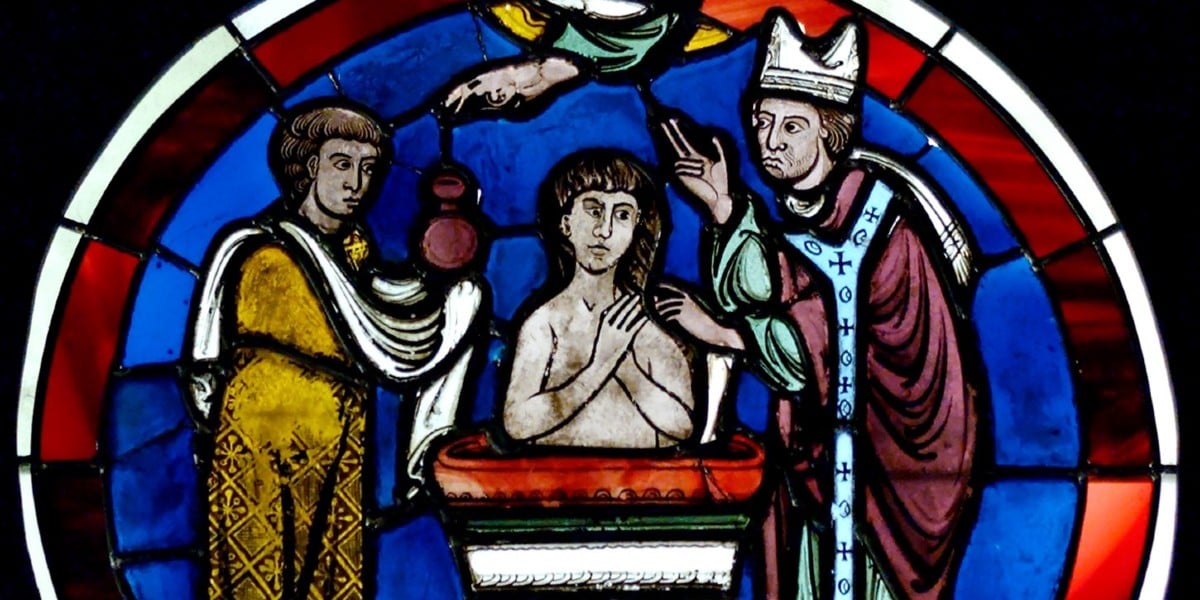Pope Leo XIV – Inaugural Mass Homily
Elected on May 8, 2025, as the 267th successor of St. Peter, Pope Leo XIV’...

St. Ambrose of Milan tells newly baptized Christians the meaning of the post-baptismal rites following baptism: the clothing with white garments and the anointing with chrism, the sacred oil, which we call the sacrament of confirmation or, in the Eastern churches, chrismation.
A fter this you went up to the priest. Consider what followed. Was it not what David spoke of when he said: Like oil on the head, running down on the beard, the beard of Aaron?
This is the oil spoken of also by Solomon: Your name is oil poured out, so that the maidens loved you and attracted you. How many souls, reborn today, have loved you, Lord Jesus, and have said: Draw us after you; we shall make haste to follow you, in the fragrance of your garments, to breath the fragrance of resurrection.
Understand why this is done: Because the eyes of the wise man are in his head. The oil flows down on the beard, that is, on the grace of youth; it flows on Aaron’s beard, in order to make you a chosen race, a race of priests, bought at a great price. We are all anointed with spiritual grace to share in God’s kingdom and in priesthood.
Then you received white garments as a sign that you had cast off the clothing of sin and put on the chaste covering of innocence, as the psalmist prophesied: You will sprinkle me with hyssop and I shall be cleansed, you will wash me and I shall be made whiter than snow.
One who is baptized is seen to be made clean in terms of the law and of the Gospel. In terms of the law, because Moses used a bunch of hyssop to sprinkle the blood of the lamb; in terms of the Gospel, because Christ’s garments were white as snow when in the Gospel he revealed the glory of his resurrection. The sinner who is forgiven is made whiter than snow. The Lord promised the same through Isaiah: If your sins are as scarlet, I will make them white as snow.
Wearing the garments given her in the rebirth by water, the Church says, in the words of the Song of Songs: I am black but beautiful, daughters of Jerusalem. Black because of the frailty of humanity, beautiful through grace; black because she is made up of sinners, beautiful through the sacrament of faith. When they see these garments the daughters of Jerusalem cry out in wonder: Who is this who comes up, all in white? She was black, how is she suddenly made white?
When Christ sees his Church clothed in white – for her sake he himself had put on filthy clothing, as you may read in the prophecy of Zechariah – when he sees the soul washed clean by the waters of rebirth, he cries out: How beautiful you are, my beloved, how beautiful you are; your eyes are like the eyes of a dove, for it was in the likeness of a dove that the Holy Spirit came down from heaven.
Remember, then, that you received a spiritual seal, the spirit of wisdom and understanding, the spirit of knowledge and reverence, the spirit of holy fear. Keep safe what you received. God the Father sealed you, Christ the Lord strengthened you and sent the Spirit into your hearts as the pledge of what is to come, as you learned in the reading from the Apostle.
For the previous section of Ambrose’s On the Mysteries, click here.
This instruction to new Christians explains the post-baptismal rites including the white garment and the anointing of confirmation. It is an excerpt from St. Ambrose of Milan’s book On the Mysteries (No. 29-30. 34-35. 37. 42: SC 25 bis, 172-178). This selection on the post-baptismal rites appears in the Roman Office of Readings for Thursday of the fifteenth (15th) week in ordinary time. The accompanying biblical reading is from 1 Kings 22: 1-38, the story of the King of Israel’s death following the battle at Ramoth-Gilead.
For more resources on the sacramental instruction of newly initiated Christians during the Easter Season, see the BAPTISM SECTION of the Crossroads Initiative Sacraments Library.
Banner/featured image Scene of baptism from the Sainte-Chapelle of Paris, last quarter of the 12th century. Public domain.
No Comments